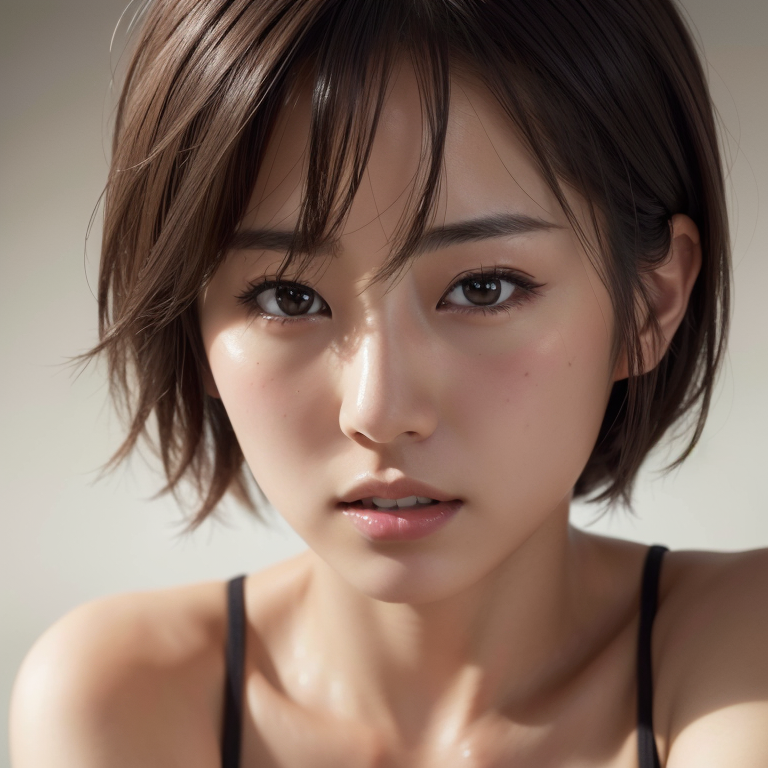最終更新日:2023年8月2日
はじめに
SDXL 1.0はベースとリファイナーの2つのモデルからできています。今回はベースモデルとリファイナーモデルでそれぞれImage2Imageをやってみました。Text2ImageはSDXL 1.0のベースモデルを使わずに「BracingEvoMix_v1」を使っています。SDXL 1.0の基本的な使い方はこちらを参照して下さい。touch-sp.hatenablog.com
方法
Text2Image
from diffusers import StableDiffusionPipeline, EulerAncestralDiscreteScheduler import torch from compel import Compel, DiffusersTextualInversionManager model_id = "model/BracingEvoMix_v1.safetensors" pipe = StableDiffusionPipeline.from_single_file( model_id, load_safety_checker=False, extract_ema=True, torch_dtype=torch.float16) pipe.scheduler = EulerAncestralDiscreteScheduler.from_config(pipe.scheduler.config) pipe.load_textual_inversion("embeddings", weight_name="EasyNegative.safetensors", token="EasyNegative") pipe.to("cuda") prompt = "(high resolution)++, 8k+, photorealistic+, attractive, highly detailed, photo of pretty Japanese woman, short hair" negative_prompt = "EasyNegative, (Worst Quality)++, (low quality)+" textual_inversion_manager = DiffusersTextualInversionManager(pipe) compel_proc = Compel( tokenizer=pipe.tokenizer, text_encoder=pipe.text_encoder, textual_inversion_manager=textual_inversion_manager, truncate_long_prompts=False) prompt_embeds = compel_proc([prompt]) negative_prompt_embeds = compel_proc([negative_prompt]) generator = torch.Generator(device="cuda").manual_seed(20700) image = pipe( prompt_embeds=prompt_embeds, negative_prompt_embeds = negative_prompt_embeds, generator=generator, num_inference_steps=25, guidance_scale=7.0, width=768, height=768 ).images[0] image.save("evo.png")

この画像を使ってImage2Imageを行います。
Image2Image
strengthを0.2→0.3→0.4→0.5→0.6と変更しながら画像を作成しています。ベースモデルを使う場合
import torch from diffusers import AutoPipelineForImage2Image from diffusers.utils import load_image pipe = AutoPipelineForImage2Image.from_pretrained( "stabilityai/stable-diffusion-xl-base-1.0", torch_dtype=torch.float16, variant="fp16", use_safetensors=True ).to("cuda") init_image = load_image("evo.png").resize((1024, 1024)) prompt = "masterpiece, best quality, high quality, 8k, kawaii princess" negative_prompt = "worst quality, low quality, medium quality" strength_list = [0.2, 0.3, 0.4, 0.5, 0.6] for strength in strength_list: image = pipe( prompt=prompt, negative_prompt=negative_prompt, image=init_image, strength=strength).images[0] image.save(f"img2img_base_strength{strength}.png")
リファイナーモデルを使う場合
import torch from diffusers import AutoPipelineForImage2Image from diffusers.utils import load_image pipe = AutoPipelineForImage2Image.from_pretrained( "stabilityai/stable-diffusion-xl-refiner-1.0", torch_dtype=torch.float16, variant="fp16", use_safetensors=True ).to("cuda") init_image = load_image("evo.png").resize((1024, 1024)) prompt = "masterpiece, best quality, high quality, 8k, kawaii princess" negative_prompt = "worst quality, low quality, medium quality" strength_list = [0.2, 0.3, 0.4, 0.5, 0.6] for strength in strength_list: image = pipe( prompt=prompt, negative_prompt=negative_prompt, image=init_image, strength=strength).images[0] image.save(f"img2img_refiner_strength{strength}.png")
結果
上の画像がベースモデル、下の画像がリファイナーモデルを使った結果です。左からstrengthを0.2→0.3→0.4→0.5→0.6と変更しています。


リファイナーを使った場合、strengthは0.5あたりから画像が乱れてきました。